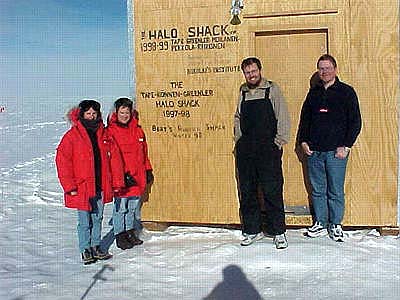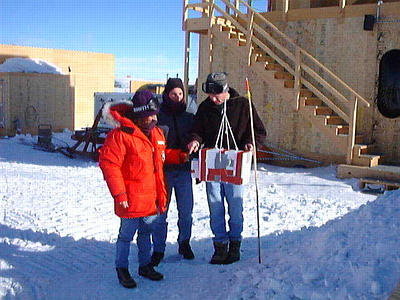12 January, 1999
Tuesday, January 12th, 1999, South Pole Station
Hello from the South Pole! Another beautiful summer day in the
Antarctica. Today will be an ozonesonde launching day!
After breakfast, I checked my email and answered questions. The rest
of the morning, I worked with Bryan in the Balloon Inflation Facility
or BIF. Together with meteorologists, this facility is used to
inflate balloons that have instruments attached to conduct certain
measurement. Our Balloons have ozone sonds attached which measure
ozone concentration, temperature, air pressure, and altitude while
rising.
Principle of an ozonesonde:
As I have described in my journals from the summer, these sonds are
two electro-chemical cells . One is an anode and the other a cathode.
Both cells contain potassium iodide solutions. While the balloon
rises, a small piston pump pumps air through the solution. The ozone
in the pumped air reacts with the iodine solution and produces ions
that create a current, which is proportional to the ozone
concentration in the air.
The piston pump operates by a buttery. An electronic interface board
translates all the data points to the radiosonde. The radiosonde
submits the data to a converter. The radio signals are converted into
the computer language and the measurements appear as a graph plotted
with rising altitude.
Preparations of ozonesondes for the flight:
Each sonds has to be conditioned 3-5 days before the flight by
'flushing' alternatively high ozone (produced with an ozone generator
in the lab) and no ozone. The solutions in the cells have to be
changed, and the sonde is then stored. On the day of the flight, the
solution of the sondes have to be changed again, The dry and whet flow
rate has to be determined in order to correct for any changes due to
humidity in the air. The background ozone has to be measured as well.
Once all the parts are connected, the sonde is placed into a box
measuring 20cmX20cm X30cm. It is tested if the sonde can signal the
radio receiver connection in the lab, in other words, we find out if
our instruments can 'talk to each other'. The whole box is then placed
outside in order to condition the sonde to the outside condition. At
the same time, we test if the instrument works correctly by comparing
its surface measurements with ours, i.e. temperature and air pressure.
In the mean time, a balloon is inflated with helium. We added enough
helium so that 2000gr 'weigh off weight' can be lifted. The balloon
is then tied and a parachute is attached. Then the box with the sonde
can be attached and everything can be launched and the data collection
can be observed on the monitor. At a certain altitude, the balloon
bursts (does any body know at what altitude this might be?) and we can
observe the sonds' data collection at its descent. The sonde is
usually not retrieved.
What do you think a 'weigh-off-weight' is? Why do you think we have to
be careful inflating the balloon with the right amount of helium?
Besides continuing with the routine ozone data collection using a
single sonde, the following research will be conducted during my stay
here at the South Pole:
Comparative field testing of Ozone data collection at the South Pole,
Jan., 1999 and student parcticipation in data analysis in classrooms:
Background information to the field-tests at the South Pole
During recent international workshops scientists compared their
methods of collecting ozone data. Since all data is compared
globally, methods used must produce the same data when used under
identical conditions. Bryan's experiments suggested that the
buffered 1% Potassium Iodide solution (KI, used in his ozonesondes
for many years) calculate slightly higher ozone values than that of
the solutions used by other scientists of different countries. His
experiments in the lab have shown that the buffer in the solution
contributes to the higher ozone values. He concluded that the
solution should not be buffered. Bryan conducted further controlled
experiments in the lab and concluded that a 2% KI unbuffered solution
measures correct ozone values. Similar tests were also conducted in
the lab in Boulder using new and/or different ozonesonde models.
The new solution together with new ozone models needed to be tested in
the field. We will conduct this field testing here at the South Pole.
We hope to be able to confirm with this work that previous data
collected with the 1% IK buffered solution needs to be corrected.
Data collection at the South Pole
A) Comparison of methods. This project is designed to:
1. compare ozone concentrations collected with sondes containing two
different concentrations of Potassium Iodide (KI) solutions (1% KI,
buffered and 2% KI, unbuffered. This requires launching a double
ozonesonde.
a) using latex balloons, which are used during the
Antarctic summer
b) using plastic balloons, which are used during the
Antarctic winter
2. compare data collection of an older ozonesonde model with that of
two new models using the solutions tested in the first experiment.
his requires launching two triple sondes
3. evaluate and possibly correct data collected in the past
B) Compile and compare several seasonal and annual data collected at
the South Pole over the past 20 years and determine the difference in
ozone concentration.
Today we completed number one! It was a very successful flight!! I
will be mailing out the raw data soon for students to plot during
class activities. IF YOU ARE INTERESTED PARTICIPATING, PLEASE CONTACT
ME VIA MY EMAIL LINK AT THIS SITE.
berghoel@spole.gov
or
bergholz@tea.rice.edu
By the way, who knows what a buffer is? Let me know!
After the launch, Andy and I had lunch and Bryan stand by the radio
receiver. He made sure that the radio data signals from the rising
ozonesonde would come in strong enough to be read by our receiver. He
would make corrections if necessary. Sometimes, changing the direction
of the antenna is necessary. When Andy and I were done eating, we
went back the BIF to give Bryan a chance to eat. The whole launch
lasted about 21/2 -3 hours, including the descending time.
Late afternoon, my Principle Investigator, Dave Hofmann, arrived
finally from Christchurch and McMurdo. We gave him a good welcome and
talked about our plans for the weeks to come. After dinner, the Dutch
and French South Pole racers gave a talk about their experience. What
a team!! We are still expecting Peter Hillary. We heard he and his
partner should arrive around January 21st. We also heard that they had
bad weather, did not make much progress and that they are running out
of food. I hope they will be o.k.
About our question from yesterday: What is the Antarctic Treaty?
Antarctica is not owned by any nation. The countries that conduct
research in the Antarctic found it most essential to protect this
continent from any type of exploitation. These countries worked
together to come up with the Antarctic Treaty, which was originally
signed by 12 countries in 1961: Argentina, Australia, Belgium, Chile,
France, Germany, New Zealand, Norway, USSR, South Africa, USA, United
Kingdom. The Treaty includes now 43 countries. Some of these countries do
not have any research stations in the Antarctic. The flags of these
countries are posted around the Ceremonial Pole.
The Antarctic Treaty summarizes the following:
Antarctica should be used for peaceful purposes only
The freedom of science is guaranteed and the sharing
among scientists is promoted.
On-site inspection by foreign observers is allowed to make
sure that the Treaty is being followed.
Territorial claims are not recognized, disputed, or established.
Nuclear explosions and the disposal. of nuclear waste
are prohibited.
Other Treaties have been signed and I will talk about on Sunday -the
17th of January- inhonor of Scott who arrived here at the South Pole
January 17th, 87 years ago.
Keep asking questions. I enjoy answering them and I am
glad that I can share this incredible experience with you. Until
tomorrow!

Elke and TEA colleague Sue Bowman!

Andy,Joel , and I are placing the dual ozone outside for conditioning.
Contact the TEA in the field at
.
If you cannot connect through your browser, copy the
TEA's e-mail address in the "To:" line of
your favorite e-mail package.
|
